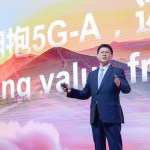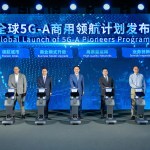Viewpoint
Over the last few years, Huawei has developed several innovative products that empower service providers to maximize the benefits of 5G and 5.5G market opportunities.
"We will enhance eMBB [enhanced Mobile Broadband], URLLC (Ultra Reliable Low Latency Communications) and mMTC (massive Machine Type Communications) and provide new capabilities of high-precision sensing and positioning, passive IoT, and native intelligence. With them we will build intelligent 5.5G networks that support 10Gbps downlink, 1Gbps uplink and 100 billion connections, embarking on a new journey of 5G," says Yang Chaobin, President of Huawei’s Wireless solution, while delivering a keynote speech on `Continuous Innovation Towards 5.5G for a New Journey of 5G Industry’.
5G enhancements are crucial to support new and innovative use cases, improve the user experience, and increase the services’ uptake. As the popularity of XR Pro and other toC services continues to grow, the networks must increase user-perceived rates tenfold for mobile connections. Further, new-age use cases like vehicle-to-everything (V2X) and other new toB services also demand high uplink speeds and high-precision positioning.
"This means that 5.5G networks must provide a downlink speed of 10 Gbps and an uplink speed of 1 Gbps, compared with 4G. They must also support 100 billion IoT connections and become natively intelligent," commented Chaobin. In his speech, Chaobin spoke about the technologies that are helping service providers enhance network performance.
Extremely Large Antenna Array for greater coverage
Several technological approaches are helping the service providers in enhancing network performance. For instance, Extremely Large Antenna Array (ELAA) Massive Multiple Input Multiple Output (MIMO) are becoming crucial as ultra-large bandwidth has proven to be essential to mobile networks, requiring all sub-100GHz resources, including FDD spectrum, C-band, 6GHz and millimetre Wave to be fully utilized.
"ELAA enables high-band networks to provide the same coverage as C-band so that operators can provide 10 Gbps to all users no matter where they are. ELAA MetaAAUs have been put into commercial use on 3.5 and 2.6 GHz bands in more than 30 cities. Field tests have been completed on the 6 GHz band, showing that co-coverage with C-band is possible in cases where outdoor deployments cover outdoor (O2O) and indoor (O2I) users," explained Chaobin during his address. ELAA also significantly helps mmWave reduce penetration loss to ensure an overall peak rate of 10 Gbps, with a Gbps experience possible even at a distance of 5 km.
Downlink and Uplink Decoupling
Another challenge the carriers face is that business users typically require higher uplink speed than downlink ones. With the uplink decoupled from the downlink, the toB services can flexibly use the uplink and downlink spectrum on different bands.
"Aside from existing FDD spectrum, uplink-only spectrum can be added to support Super Uplink (SUL) that ensures a much higher uplink bandwidth. Through uplink/downlink decoupling, both the spectrum can be converged to ensure a Gbps uplink. To date, uplink/downlink decoupling has been deployed across a wide range of scenarios, such as mines and steel plants, to ensure 1 Gbps uplink transfer required for 100-channel HD backhaul, panoramic remote control, and remote real-time quality inspection," explains Chaobin.
RedCap IoT for medium and high-speed connections
5G-based RedCap IoT supports medium and high-speed connections and is already commercially available. Compared with eMBB, RedCap features a low power consumption and high-cost effectiveness, making it possible for carriers to deploy it on a massive scale. Passive IoT combines cellular communications and passive tagging and features low terminal prices and long coverage distances, providing an ideal option for connecting tens of billions of passive IoT devices.
"Based on Huawei’s verification, passive IoT supports a coverage distance exceeding 200 meters. Additionally, sensing will be integrated onto mobile networks, facilitating the use of mmWave high bandwidth to improve sensing precision. As such, speed and distance measurements and imaging will be enhanced to further improve exception identification for smart transportation, geo-fencing for smart factories, and other industry applications, ultimately enabling digital replica," says Chaobin.
Leveraging Network Intelligence to Maximize Resource Utilization
5G and 5.5G developments will increase service varieties and differentiation with networks running with multiple bands and radio access technologies running concurrently. There is then an urgent need to introduce intelligence in the networks so the carriers are able to ensure maximum resource utilization and ensure toC, toB, and toH service experiences. Further, intelligence is also required to balance network performance and energy consumption, which is essential to fulfilling the growing 5G traffic demand.
"The native intelligence will further enable networks to facilitate real-time sensing, modeling and prediction, and multidimensional decision-making. As such, networks will be intelligently optimized, with various resources to be configured on demand to deliver optimal user experience and capacity. O&M will be intelligently simplified, with site planning, deployment, and troubleshooting automated to maximize performance and energy saving," Chaobin elaborated in his address.
Huawei will continue to develop products and solutions addressing the pain points of the carriers and helping them maximize the available market opportunities.
















